Ye gods the Bills at Panthers game was awful to behold, and not just because no touchdown was scored. Dropped passes, missed assignments, overthrown receivers—these guys are paid millions of dollars a year and the owners wallow in public subsidies. How could the result be so crummy? The game is almost over, Carolina leads by the baseball score of 6-3 and faces 3rd-and-goal, and number-one overall draft pick and former MVP Cam Newton badly misses an open receiver, whose catch would have put the contest out of its misery.
This game was so bad, the football gods were looking for something to watch on Netflix. Later in the season Tuesday Morning Quarterback will lay out the mythology of the football gods. My favorite is Lambasthor, god of halftime tirades.
Now the Panthers lead 9-3 and Buffalo has 4th-and-11 on the home team’s 33 with 14 seconds remaining. Fourteen seconds, visitors trail by six: That means the pass absolutely must go to the end zone. Yet Carolina’s defensive backs pull up short, then stand watching as Buffalo receiver Zay Jones streaks toward the goal line. This climactic down came after a Carolina time out, during which coaches, you’d kind of think, would have mentioned, Guys, the pass is going to the end zone. Ignored by the Cats’ defense, Jones is alone at the Carolina 1—and drops the ball, a fitting conclusion to another weekend of low-quality NFL play.
Cincinnati and Santa Clara have not scored a touchdown this season. Jersey/A and Seattle have but one touchdown. Games have ended with scores of 9-3, 12-9, 13-9, 23-3, 19-3, and an excruciating 16-13 in overtime. (“Darling, we’ll always have Arizona versus Indianapolis. It seemed like time stood still.”) There have only been 32 games so far, and already three have offered missed last-second field goals from makeable distances. If these outcomes were results of great defense, that would be one thing. But missed tackles and blown coverages abound. Many football enthusiasts are asking—what’s happening with quality of play?
If scoring is the barometer, the 2017 season, in which teams have scored an average of 20.1 points per game, is only somewhat disappointing. The seven most recent seasons have seen the same statistic average from 22 to 23.4, but 20.1 just isn’t that different. Something else is going on in the perception of declining quality of play.
Maybe it’s that less contact time in practice results in players whose basic block-and-tackle skills are not polished. Less contact time in practice sets the right example for high school and college—sports sanctioning bodies in California and Texas have reduced contact hours at the high school level. Less practice contact in high school and college football is a positive reform, considering the overwhelming majority of prep and collegiate players never receive any monetary benefit from sports. (Concussion risk below the NFL level will be the topic of the October 10 TMQ, so hold that thought.) Professional players, on the other hand, are elaborately warned and richly compensated. The pendulum may have swung too far in the direction of protecting NFL players at the expense of the quality of their play.
Maybe it’s that the 7-on-7 generation has spent too much time executing quick hitches and not enough time refining the rest of the game. The fad for 7-on-7 began at the high school level around the year 2000, and has produced many quarterbacks who are proficient at throwing the quick hitch against no pass rush. Children of 7-on-7 leagues now dominate the NFL.
Maybe it’s that the shotgun spread/zone read/RPO fad sequence that began at the college level around the year 2005 produces players whose skills don’t translate to the NFL. It’s not that today’s college quarterbacks do not know how to do “progressions,” or looking at receivers in sequence. Purists grumble this complaint, which does not ring true to me—for decades, college offenses have had single-side progressions in which the quarterback looks either left or right but does not scan the whole field. At the professional level, quarterbacks must learn full-field progression; this has been the case for a long time. It’s more that the shotgun spread/zone read/RPO craze produces receivers who do not know how to read coverages to “sight adjust” (react to what the defense offers), because the college craze is the same three patterns (bubble screen, deep sideline, and shallow out) endlessly repeated.
And it’s that contemporary offensive linemen come out of college accustomed to brush-blocking their men, then jogging downfield. In a quick-screen offense, that’s fine. At the professional level, it’s not fine. Audiences rarely watch the linemen. Take a tip from TMQ—Keep Your Eye Off the Ball. You’ll be distressed at how many NFL offensive linemen, however muscular, seem really confused about what they’re supposed to be doing.
But although the NFL has treated the NCAA for generations as a free junior league, preparing players for professional cleats is not what college football should be doing. College football should be about education for players, entertainment for students and alumni, and creating autumn rituals that advance the life of the college. If NCAA football is failing to prepare ideal pros, I could not care less and neither should you. (The NCAA has way too many problems of its own, in any event.)
Maybe the issue with the perception of NFL decline is that fear of traumatic brain injury turns professional football into a guilty pleasure. Sunday, the Broncos’ Bennie Fowler took a knockout head hit that left him woozy and unable to walk without staggering. “That’s difficult to watch,” Fox’s Joe Buck said. (By Monday, Fowler seemed basically okay.) Until the most recent decade, football concussions were covered up or laughed off, while announcers changed the subject. Now, the sight of brain harm raises uncomfortable comparisons between the NFL and professional prizefighting, which fell out of favor over the sense that society should not encourage spectacles that led to “boxer’s brain.” Focusing the camera on the concussed player lying motionless is the right thing to do; stopping the game to immobilize that player on a board is the right thing to do. But awareness of TBI makes watching football less fun, contributing to the perception of declining quality.
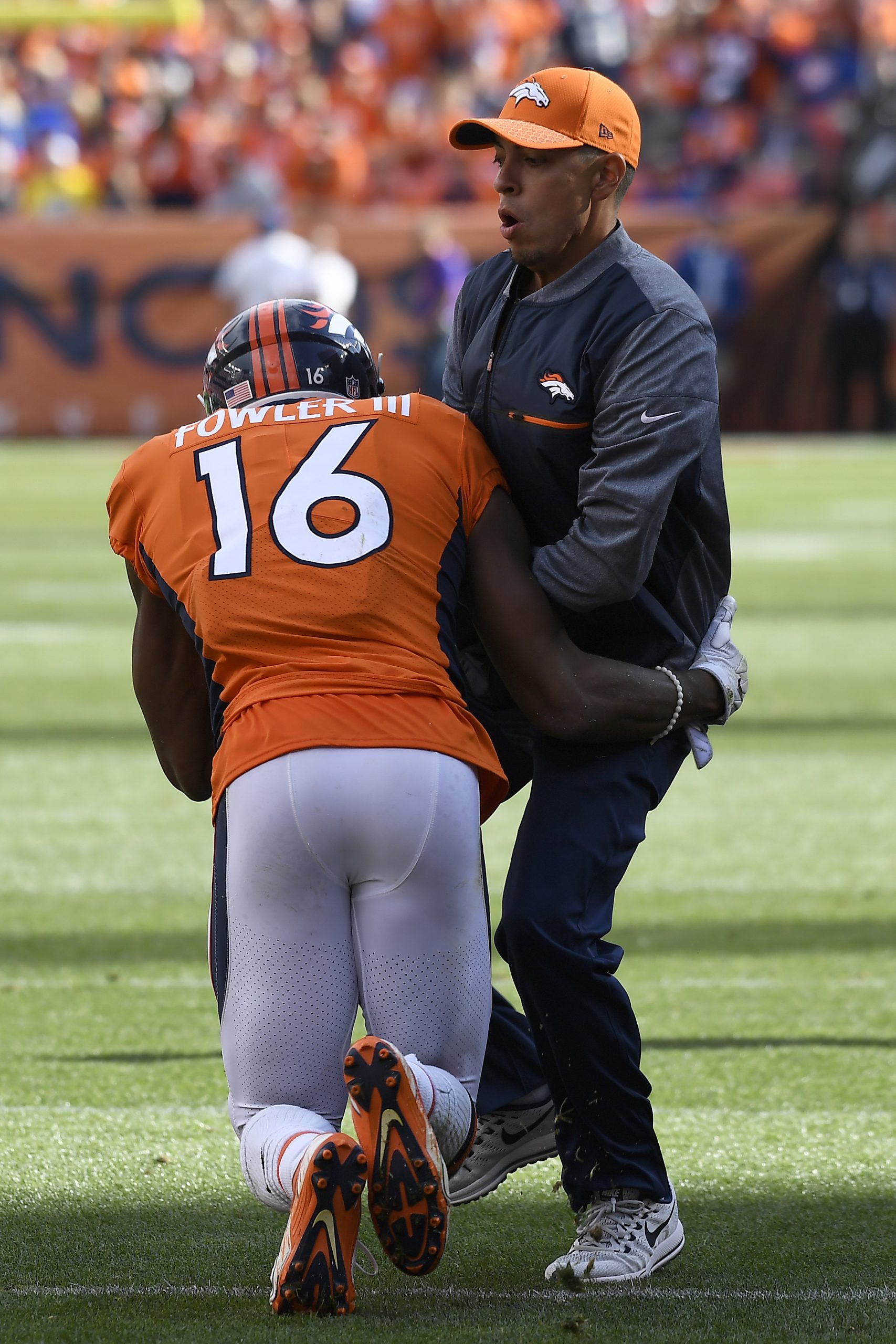
Bennie Fowler (16) of the Denver Broncos stumbles after being hurt on a play in the second quarter of a game against the Dallas Cowboys, Sunday, September 17, 2017. (Photo by John Leyba/The Denver Post via Getty Images)
In turn, awareness of traumatic brain injury makes public subsidies to fat-cat NFL owners even more offensive than before. Brookings Institution researchers calculate at least $3.7 billion in federal handouts to professional sports stadia, a number that does not include local subsidies to the new Falcons field that debuted Sunday.
Promoted as privately financed, that field will receive at least $200 million in public subsidies, likely far more, via delayed payments designed not to be received until the spotlight has moved elsewhere. Ken Belson of the New York Times had the details last January. Naught said about this during NBC’s on-air celebration of the new stadium Sunday night. Very wealthy NFL owners are lavished with subsidies, then promote their products over public airwaves—and their product causes brain harm. The more awareness of this, the more the NFL can seem offensive. That translates, in a sense, to the game not being as much fun as it once was.
One other aspect of the impression of declining play is that the explosion of sports information—stats, replays, the “A22” skybox view of NFL games—take some of the magic out. When all most people could do was watch one NFL game live on regular television, the quick-cut to an open receiver implied he’d done something spectacular to beat the defense. Pause your Xfinity and roll back, or check the A22, or scan social media posts, and you’re likely to realize what really happened is that the receiver ran in a straight line and a defender fell down.
NFL coaches once were viewed as possessed of incredible insiders’ secrets; with each successive year, more and more high school kids know all those secrets. When the Falcons can’t hold a 28-3 second-half Super Bowl lead because they insist on calling deep-drop passes rather than working the clock, NFL coaches look like idiots. It’s more entertaining to believe something magical is happening. And that belief is fading.
Stats of the Week #1. Both Chargers games have come down to LA/B missing a field goal on its final snap.
Stats of the Week #2. Stretching back to last season, Pittsburgh has followed an 0-4 run with an 11-1 run.
Stats of the Week #3. Green Bay has played two of its last three games at Atlanta, falling behind a combined 48-7 by halftime.
Stats of the Week #4. As coach of the Ravens, John Harbaugh is 17-2 versus the Browns.
Stats of the Week #5. Stretching back to the start of the 2015 season, the Saints have allowed 78 touchdown passes in their last 34 games.
Stats of the Week #6. Andy Dalton is 1-6 against the Houston Texans.
Stats of the Week #7. Cincinnati Bengals possession results for the season so far: Punt, interception, interception, punt, interception, punt, fumble, punt, punt, downs, interception, end of game; punt, punt, fumble, field goal, punt, punt, field goal, field goal, punt, punt, punt, downs, end of game.
Stats of the Week #8. Andy Reid is 9-3 versus head coaches who are his former assistants.
Stats of the Week #9. Jacksonville has won by 22 points and lost by 21 points.
Stats of the Week #10. Stretching back to last season, Kansas City is on a 12-3 run with all losses by less than a field goal.
Sweet Play of the Week. Contest tied in the fourth quarter, Kansas City faced 2nd-and-5 on the Philadelphia 15. The Chiefs lined up with a slotback on each side of Alex Smith. At the snap, he faked to one, then faked to the other going the opposite way, then flipped a shovel pass straight ahead to tight end Travis Kelce, who had crossed beneath the line of scrimmage. Sweet touchdown, and the Chiefs never looked back.
Sour (Defensive) Play of the Week. Game tied at 10, the Bolts faced 2nd-and-goal on the Marine Mammals’ 7. LA/B lined up trips right with Antonio Gates as the slot man. Miami did not put a linebacker across from Gates and did not jam him at the line, jamming the tight end at the line being essential strategy on goal-to-go passing plays. In fact, Miami did not cover Gates at all: He ran a quick curl and caught a touchdown pass. How could the Miami defense possibly have suspected the ball might go to Gates in the end zone? Because this had only happened 111 times before! And now Gates holds the NFL record with 112 touchdown receptions by a tight end.
Sour Bonus. Dolphins leading 19-17, the Chargers had the ball at the Miami 26 with 10 seconds remaining. Out of time outs, the Chargers were in a state of mass confusion with members of the offense and of the kicking team on the field simultaneously, and Philip Rivers gesticulating wildly. Miami called time out. Sportsyak would be mocking this time-out—which allowed LA/B to get organized for a kick—had Chargers rookie placekicker Younghoe Koo not missed.
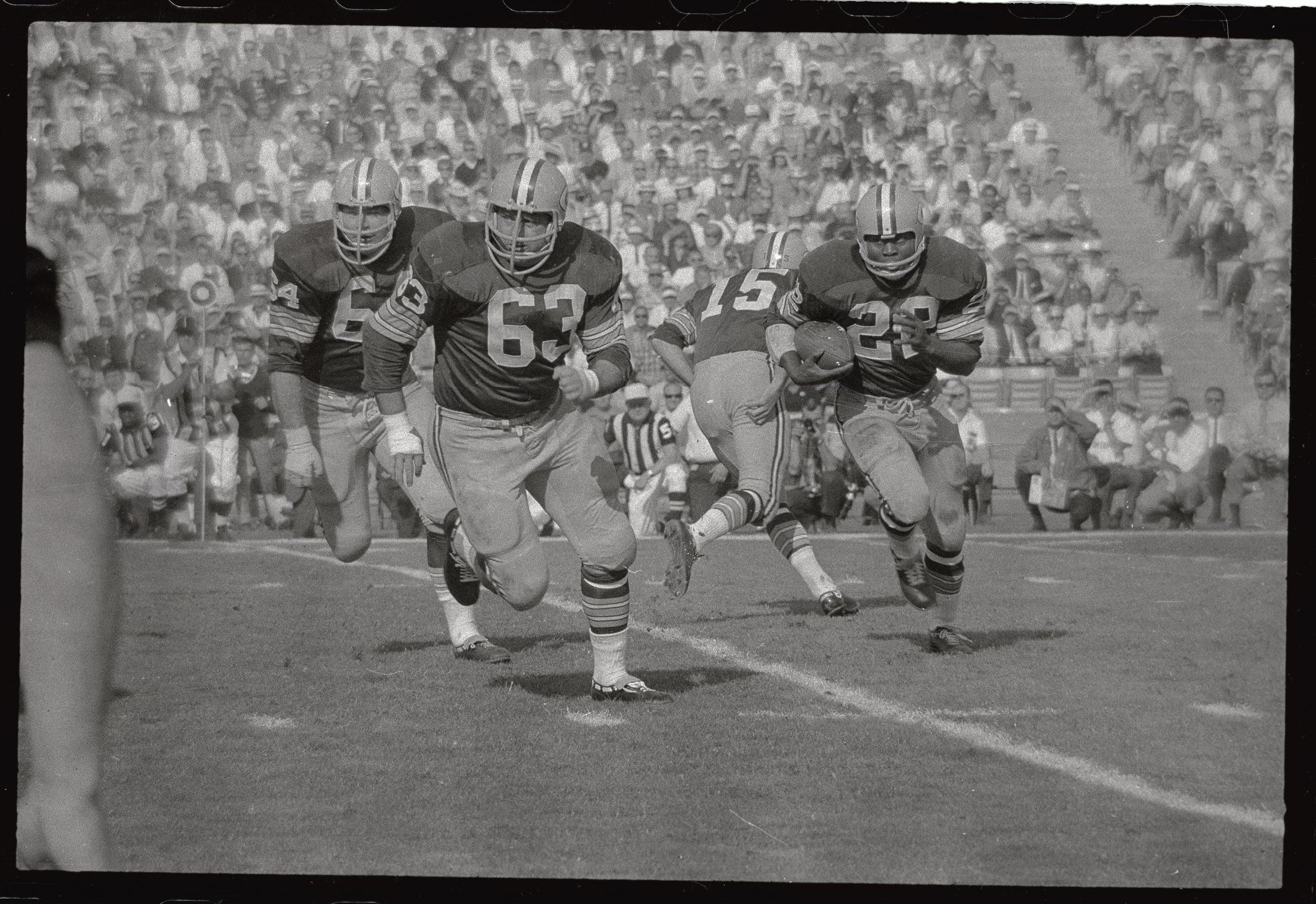
Coupled with the driving interference of Jerry Kramer (64) and Fuzzy Thurston (63), Green Bay’s Elijah Pitts picks up enough for a 1st down early in the first-ever Super Bowl.
Sweet ‘n’ Sour Play of the Week. New England leading New Orleans 13-3, the defending champions faced 3rd-and-7 on the Saints 13. Tom Brady threw a touchdown pass to Chris Hogan, which seemed sweet, until a flag for offensive pass interference turned the play sour. Officials ruled that Brandin Cooks of New England illegally blocked the man trying to cover Hogan. Indeed, on the play Cooks looked like Fuzzy Thurston leading a Packers’ power sweep in the 1960s.
Brady ran to the referee, Craig Wrolstad, and lobbied for the flag to be picked up. Brady noted, correctly, that a wide receiver can throw a block before a pass is released so long as the block is within a yard of the line of scrimmage. Surely Bill Belichick, knowing this rule, had drawn the play to ensure Cooks was within a yard of the line of scrimmage. Wrolstad did pick up the flag, and the touchdown counted—from sweet to sour and back to sweet.
With five Super Bowl rings in his collection, Brady has a standing with zebras that no other NFL player possesses. Surely Belichick told him that if this play were called back, he should politely discuss the rule with the man in the white cap. A few years ago, when the Patriots employed a semi-trick action against Baltimore, lining up a guy with an eligible number in an ineligible position, Brady immediately ran to the referee and politely recited the rule. After that season, NFL owners, many of whom are jealous of New England’s success, voted to ban the ineligible switcheroo. Don’t be surprised if this offseason holds a change of the one-yard Fuzzy Thurston rule.
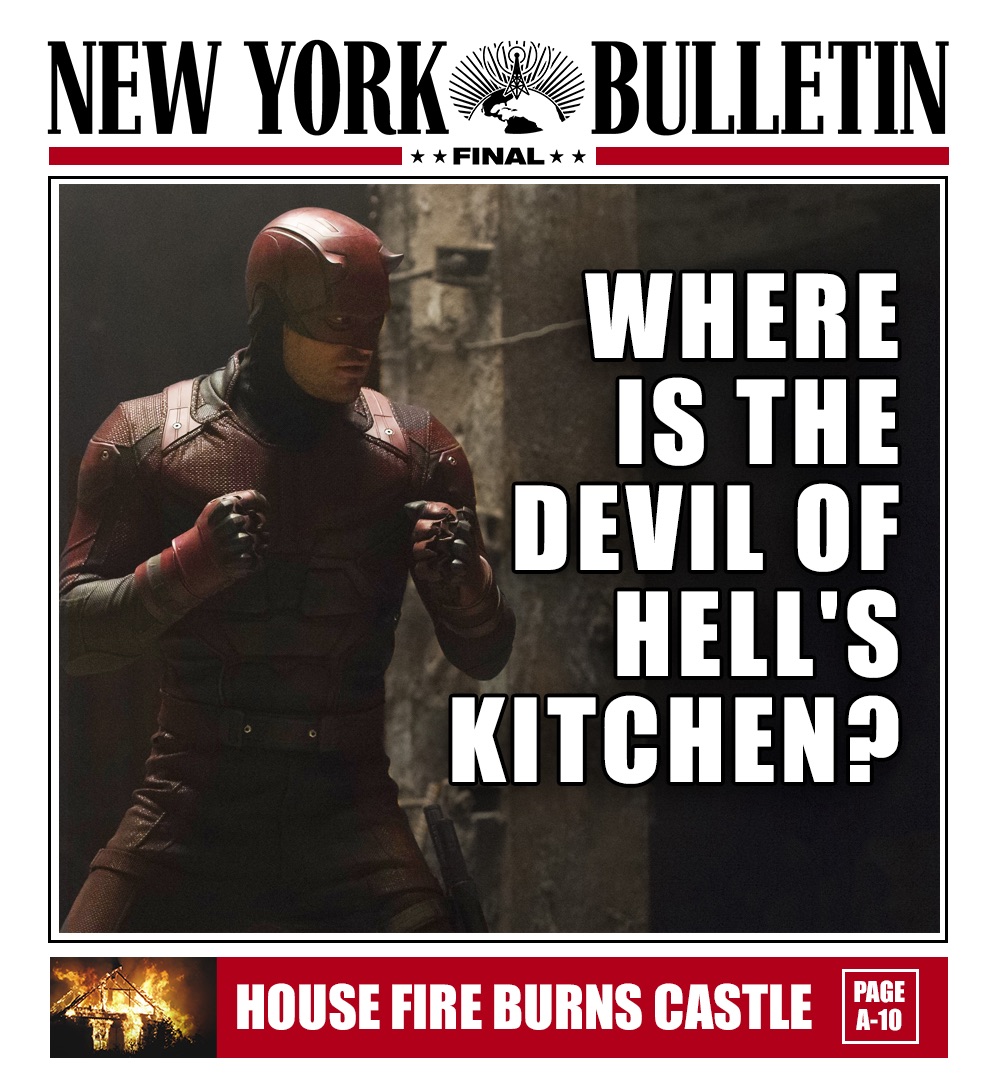
Not to be confused with the Daily News, this cover of the “New York Bulletin,” a promotion from Marvel for its new series The Defenders, depicts the superhero Daredevil. (Marvel)
Bottomless Pit Update. Marvel heroes are taking over Netflix. Daredevil, Jessica Jones, Luke Cage, and Iron Fist now have their own Netflix series, and the Punisher is coming. On Netflix, Danny Rand introduces himself as “the immortal Iron Fist.” Immortal—until he’s cancelled! Rosario Dawson, playing the comic-book heroine Claire Temple, declares in one episode, “I’ve had other friends with superpowers, and they’re all dark, haunted people.” Same here! Everybody I know with superpowers is dark and haunted.
Marvel characters appeared together in a recent Netflix crossover, The Defenders. Sorry—in Marvel’s The Defenders, which is by Marvel. If Marvel’s The Defenders were profiled in Oprah Winfrey’s O The Oprah Magazine Featuring Oprah Winfrey, there’d be no room for anything but possessory credits.
The Netflix miniseries had every possible action cliché—crawling through an air shaft, escaping through the sewers, leaping away from huge explosions. A bad guy actually said to a good guy, “You and I are much alike.” At one point Iron Fist and his fearless ninja sidekick Colleen Wing traverse the Himalayas on foot, a test one must, apparently, pass to gain admission to a mysterious Shangri-La place. Colleen patrols the streets of New York City with a katana on her back, and no one notices. Hmm … actually, in New York City, maybe nobody would notice. If the cops give her a hard time about the katana she can move to Texas, where wearing a sword in public just became legal.
All Marvel superheroes on Netflix read the New York Daily News—maybe a product placement because, like the Men in Black reading the National Enquirer to stay current on space-alien arrivals, it’s the only way they can find out about shape-shifting time travelers from other dimensions.
The McGuffin of the Defenders miniseries was the skeleton of a prehistoric flying dragon, possessed of magical powers and buried deep beneath Manhattan. (TMQ thinks that somewhere deep beneath Hollywood is an antimatter-powered McGuffin generator—probably it can be reached only by crawling through an air shaft.) Racing the good guys to the dragon skeleton was The Hand, an ancient society of super-villains. The Hand was able to build a gigantic construction project in midtown Manhattan without anyone noticing. At the core of the gigantic construction project was a bottomless pit.
Bottomless pits are TMQ’s favorite aspect of action fare. In the third Star Wars movie—third produced, sixth in the new chronology—the sinister Emperor Palpatine had a bottomless pit in his office. If you were scheming to become dictator of an entire galaxy, wouldn’t you want a bottomless pit in your office?
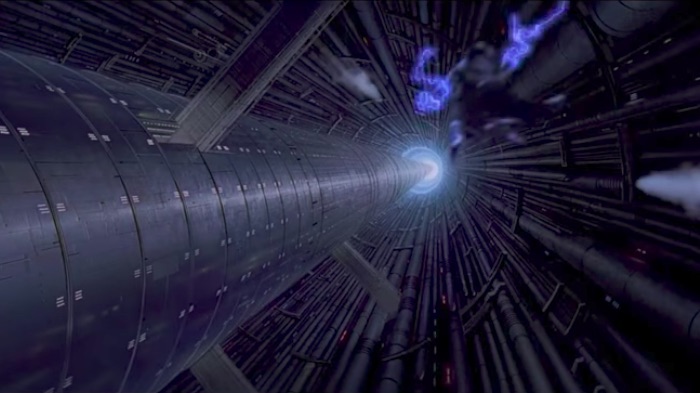
Emperor Palpatine falls to his death, or whatever it is that happens after a supervillain plummets down a bottomless pit. (Lucas Films / YouTube screen shot)
The latest Star Wars installment, Rogue One, built up to an assault on an Imperial fortress where the secret plans are hidden in a shaft that runs down the center of a bottomless pit. Stealing the plans involves crawling across a high, narrow walkway to a place where a single button must be pushed. Single buttons that control elaborate installations are another sci-fi cliché. In the 2016 Jennifer Lawrence flick Passengers, to save a miles-long megabucks hyperdrive starship carrying 5,000 colonists, Lawrence must fight her way to, and then engage on verbal command, a single toggle switch. (Passengers costarred Chris Pine or Chris Pratt—I can’t tell them apart either.)
In the latest James Bond movie, Spectre, the new MI6 headquarters is built around a bottomless pit, which of course the evildoer falls into at the end. The odd Stephen King television series Under the Dome had a bottomless pit beneath a Maine town.
In the 2009 reboot flick simply called Star Trek, there was a bottomless pit within a starship—quite a design exercise. In the latest installment, Star Trek Beyond (starring either Chris Pine or Chris Pratt), the supervillain’s lair consists entirely of bottomless pits spanned by narrow walkways, while Starfleet’s largest starbase, an artificial moon that is home to three million people, can be destroyed by pressing a single button. The high walkways in the supervillain’s lair did not have guard rails. Shouldn’t a society capable of teleportation and faster-than-light starcruisers know about guard rails?
A good way to avoid tumbling into a bottomless pit is to hang by your fingertips. A coming TMQ will obsess about that.
The Football Gods Chortled. Pittsburgh-Minnesota game scoreless, the Steelers lined up to go for it on 4th-and-1 on their own 31. Tuesday Morning Quarterback would like to see this strategy employed—but could anyone seriously believe Pittsburgh was going for it? Ben Roethlisberger barked a hard count, and Minnesota jumped offside, giving the Steelers a first down. Pittsburgh got a touchdown on the possession.
Saints trailing the Flying Elvii 20-10, New Orleans lined up to go for it on 4th-and-3 at the New England 11. That’s the spirit, go for it! Drew Brees barked a hard count and the Patriots, being the Patriots, did not jump. After being flagged for a delay-of-game, New Orleans settled for a field goal.
Outraged at such mincing tactics, the football gods awarded the Patriots two quick scores that made the contest a walkover by halftime. Then, in the third quarter, New Orleans trailing 30-13, the Boy Scouts punted in New England territory. Who cares if it was 1st-and-15—who cares if it was 4th-and-99? The week before, in the Saints-Vikings opener, Sean Payton sent in the kicker on 4th-and-goal with New Orleans trailing by 13 in the second half. What’s with the timid play-calling? Fortune favors the bold! New Orleans is 0-2 for the fourth consecutive season, and poor defense is not the sole reason.
Hosting Miami in their new mini-home, the Chargers lined up to go for it on 4th-and-1 in their own territory. Philip Rivers started barking a hard count to draw the Dolphins off, and Miami wasn’t falling for this obvious ploy. Then Rivers noticed the Dolphins had lined up with no defender over center. He tried repeatedly to get the center to snap him the ball for a quarterback sneak, which all but surely would have succeeded. But NFL players are so programmed with the notion that no one ever goes for it on 4th-and-1 that the center refused to snap. LA/B took a delay-of-game penalty and punted.
The Ticket Booth Gods Chortled. The Rams and Raiders left Los Angeles, and the Chargers departed San Diego, because of low interest in pro football in the Southern California sports market, where basketball is king. Now the Rams are back in Los Angeles, joined by the Chargers. Sunday, both played home games with announced gates of just 56,612 for LA/A at the Los Angeles Coliseum, which accommodates 90,000, and just 25,381 at the soccer pitch where the Bolts will reside for at least three seasons. The week before, on opening day, the Rams were at home and announced a gate of 60,128, though many spectators “came dressed as empty seats,” in the old vaudeville line. For Dolphins at Chargers, StubHub was offering 50-yard-line tickets behind the home bench for $280. The same category ticket for Packers at Falcons was asking $750.
Chargers Join Clippers as LACs. When the San Diego Clippers moved to Los Angeles, the NBA began to refer to the Lakers as “LAL” and to the Clips as “LAC.” But the NFL status structure refers to the Los Angeles Rams as “LA” and the Los Angeles Chargers as “LAC”—check the scores bar at the NFL website. TMQ’s cognomen, LA/A and LA/B, seem more straightforward.

An Indiana Forever stamp honors the 200th anniversary of Hoosier statehood. And 200 years from now, it’ll still be good enough to get a letter to Indianapolis. (USPS)
Maybe Beekeepers Lobbied for the “Protect Pollinators” Forever Stamp. The United States Postal Service continues to market Forever stamps, which, apparently, will last until the end of the universe. Current Forever stamps depict a 1965 Ford pickup, the Vulcan greeting gesture of Star Trek, the civil-rights pioneer Dorothy Height, and Disney villains. Let’s honor those villains! Disney trademarks are forever renewed by Congress, which protects the company by keeping characters out of the public domain for generations longer than trademark law was designed to achieve. Here you can see Forever, or at least to New Jersey.
The Postal Service maintains that no matter how much first-class rates may rise, Forever stamps always will be sufficient. A trillion years from now some cranky old coot will walk into a post office and demand to mail a letter by affixing a Forever stamp from 2017: On the plus side, a trillion years from now, the USPS finally will have balanced its budget. Will the cosmos exist for another trillion years? Perhaps for much, much longer. Consult my all-time favorite Wikipedia entry.
Buck-Buck-Brawckkkkkkk. Last month this column declared the Bengals were held back by Marvin Lewis’s “ultra-conservative” policy of punting on 4th-and-short in opposition territory. Cincinnati hosting Houston, the Bengals are in the sixth quarter of 2017 and to that juncture have scored only 3 points on the season. The Trick-or-Treats face 4th-and-inches in Texans territory—and in trots the punt unit. Just to prove it was no fluke, later in the contest the Bengals staged a 17-play drive that ended with Lewis ordering a short field goal from the Texans’ 12, though the kick left the home team trailing.
The Bengals are now 0-2, both losses at home. After the latest loss, on Thursday Night Football, Lewis scapegoated offensive coordinator Ken Zampese, firing him. All NFL offensive and defensive coordinators know that being scapegoated is an occupational hazard—they’re highly paid in part to compensate for this risk. But Zampese didn’t make the ultra-conservative decision to punt on 4th-and-inches on the other team’s side of the field.
Nice Pass But No Miracle. When Florida hit a 63-yard touchdown pass as time expired to defeat Tennessee, CBS announcer Brad Nessler called the play “a miracle,” while many in the sportsyak world, including the NCAA, described what happened as a Hail Mary.
The word “miracle” is misused in sports to mean something extraordinary. A miracle is an event that contravenes physical law—and long touchdowns don’t contravene physical law. Okay, it’s just sports, and “miracle” often is misused to mean any welcome low-probability result. Still, if there are indeed miracles, they don’t happen during football games.
And the action was not a Hail Mary, which in football is a long touchdown typically on the final play when the scoring team is expected to lose. Florida’s touchdown came with the contest tied; the scoring team was expected to go to overtime. The final down of Philadelphia-Kansas City was a Hail Mary, because the Nesharim had to complete the improbable pass, or lose.
Florida receiver Tyrie Cleveland made a nice catch and handled a broken play correctly. Most coaches teach that when the pocket collapses and the quarterback scrambles, which is what happened this time, receivers on the scramble side should come back toward the quarterback, to give him a place to unload the ball, while any receiver on the opposite side should streak to the deep middle. The latter move is in case the defensive backs on the far side, away from the scramble, think the play is over and give up—which the Tennessee cornerback did. This standard—play-side receivers come back toward the passer, opposite side receivers streak to the deep middle—often is used in Ultimate Frisbee.
Here is Gators radio play-by-play guy Mick Hubert going bonkers.
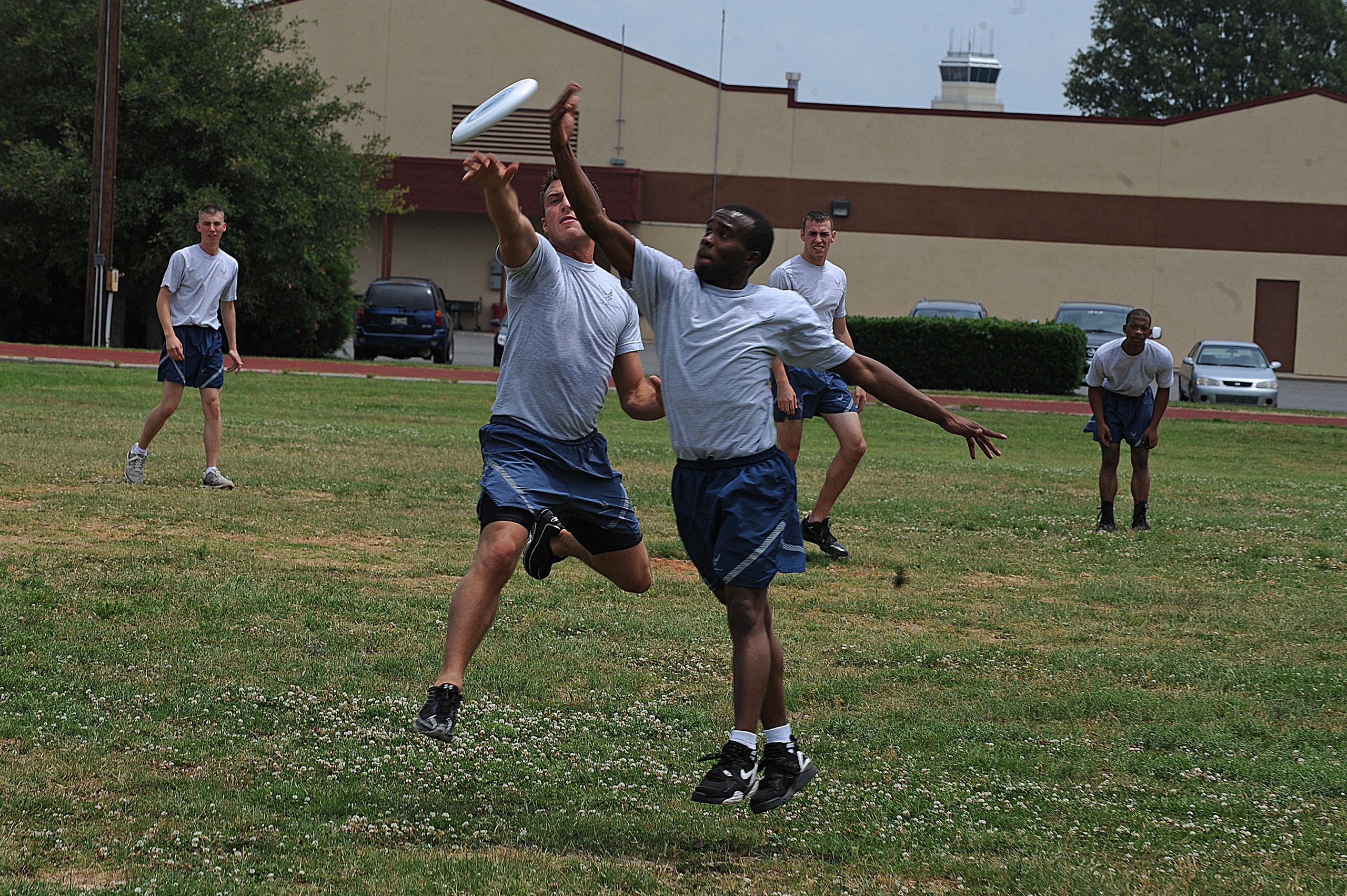
Go long! Airmen of the 26th Operational Weather Squadron play ultimate frisbee at the Barksdale Fitness Center on Barksdale Air Force Base, La. (U.S. Air Force photo/Airman 1st Class Micaiah Anthony)
Marie Antoinette Would Have Demanded a Boeing C-32. Treasury Secretary Steven Mnuchin is being ridiculed for requesting a military jet for his honeymoon in Scotland, France, and Italy, “because he is a member of the National Security Council and needed access to secure communications during the trip, according to a Treasury statement,” the Los Angeles Times reported. Mnuchin ought to be ridiculed—what, he needed secure communications to check the latest T-bill auction yield?
The tenor of the ridicule is, however, off. Commentary mocks the wealthy Mnuchin for assuming average taxpayers would pick up his tab. TMQ suspects the real problem is the Treasury secretary craved a military jet to make himself seem important—arriving at special fields, greeted by honor guards, not having to go through airport security with hoi polloi.
Though figures of both major parties say they want to be cautious with public money and to lead ordinary lives, many are consumed with the desire to seem important. Honor guards, special planes, security details, stopped traffic, cutting to the heads of lines: The touches that express, “Make way, make way, royalty coming through” are beloved by Cabinet secretaries, governors, mayors, and even midlevel functionaries.
Given the world we live in, many officials should have a police officer present when they appear in public. But this valid need has expanded into huge details whose primary function is to make the person at the center seem ultra-critically important.
Education secretary Betsy DeVos and EPA administrator Scott Pruitt have elaborate bodyguard details. A law enforcement officer there when either appears in public? Sure. But round-the-clock Marshals Service protection is not to stop terrorists, it’s to make Pruitt and DeVos seem like royalty whose feet the little people must kiss. Bill de Blasio uses an SUV security caravan when he goes to the gym, then complains about the New York Post covering this excess. When Gov. Andrew Cuomo visits Manhattan, he brings along “scores of state-paid cops” to make himself seem more important. An NYPD officer by the mayor’s and governor’s sides at all times? Absolutely. But security details and motorcades are for ego-stroking, not for protection. A police car near Janet Yellen’s house when she’s home? Sure, but an entire security presence on the block is not to stop the million-to-one risk of terrorists targeting an economic minister, it’s to sell the notion that government officials are lofty pashas. Office-holders of both parties want to sell that notion—another reason there is so much voter anger against government.
And don’t get me started on Secret Service and similar agents leaving their vehicles running, sometimes for hours, on the illusion this is needed for a fast getaway because terrorists could approach at any instant. Not only is this a million-to-one risk, but for about a decade, all new cars and SUVs have possessed chip-controlled fuel injectors that require no warmup time.

Secretary of the Treasury Steven Mnuchin (L) and Ivanka Trump arrive with President Donald Trump at Bismarck Municipal Airport September 6, 2017, in Bismarck, North Dakota. (Brendan Smialowski/AFP/Getty Images)
The Motionless Football Player. During the UCLA at Memphis contest Saturday, Memphis linebacker J.J. Russell collapsed motionless after a knockout hit. “That’s scary,” ESPN announcer Anthony Becht said. He and fellow announcer Beth Mowins then sat in silence for 40 seconds—a long time by live TV standards—till ESPN cut away to commercial.
Russell is believed to be okay. The incident showed that the sports broadcasting world simply lacks a vocabulary in which to discuss the negatives of football: traumatic brain injury, public subsidies, the corrupting effect on college education of football programs that are businesses leasing a school’s logos and tax-deductible status. All the networks that air big football—ABC, CBS, ESPN, Fox, and NBC—don’t want to address harm. They want everything to be exciting and fun and then after the game the teams hug!
When a player such as Russell is hurt in a way that clearly terrifies the announcers, this sends the message to the audience that maybe they shouldn’t be watching football in the first place. ABC, CBS, ESPN, Fox, and NBC need to gird themselves up and address the negatives of football as well as the positives.
Adventures in Officiating. In Jets at Raiders, Oakland’s DeAndre Washington caught a pass and took a stride, then was hit by Buster Skrine of Jersey/B. Officials called a personal foul on the Jets, saying Washington was defenseless because he could not see Skrine coming. He couldn’t—but by the time he was hit, he was a ballcarrier! This penalty did not impact the outcome of the contest, but was a real head-scratcher.
The 500 Club. Hosting Buffalo State, Morrisville State gained 526 yards on offense, and lost. Visiting Liberty, Indiana State gained 543 yards, and lost. Reader Eric Flear of Jonestown, Pennsylvania, notes that in Keystone State prep action, the Solanco Mules gained 524 yards on offense, scored 54 points, and lost.
The 600 Club. Visiting Memphis, UCLA gained 633 yards on offense, and lost. Reader Kevin Stambaugh of Lehi, Utah, reports that facing Lehi High School, Alta High School of Sandy, Utah, scored 66 points and lost.
Reader Animadversion. Last week a reader noted the Kia car ad in which a hamster is listed as a “professional driver.” Reader Jenna Carpenter of Corvallis, Oregon, reports this Subaru advert shows a dog behind the wheel and cautions, “Professional driver do not attempt.” Why can’t my Labrador retriever get a job as a professional driver?
Obscure College Score. Liberty 42, Indiana State 41 in a matchup of Flames versus Sycamores. Located in Terre Haute, Indiana State lists its favorite food as French fries with cheese, pulled pork, BBQ sauce, and ranch dressing.
Bonus Obscure College Score. Texas Lutheran 37, Belhaven 0. Tyler Hopkins of Texas Lutheran hit an unusual double-kick field goal. Belhaven blocked his placekick attempt, and as the ball rolled around, Hopkins kicked it a second time, through the uprights. Because no player had possessed the ball between the block and the second swing of the leg, officials ruled it a drop kick. Located in Jackson, Mississippi, Belhaven University takes branding seriously.
Next Week. The glorious reboot of a TMQ running item, New York Times Corrections on Fast-Forward.

